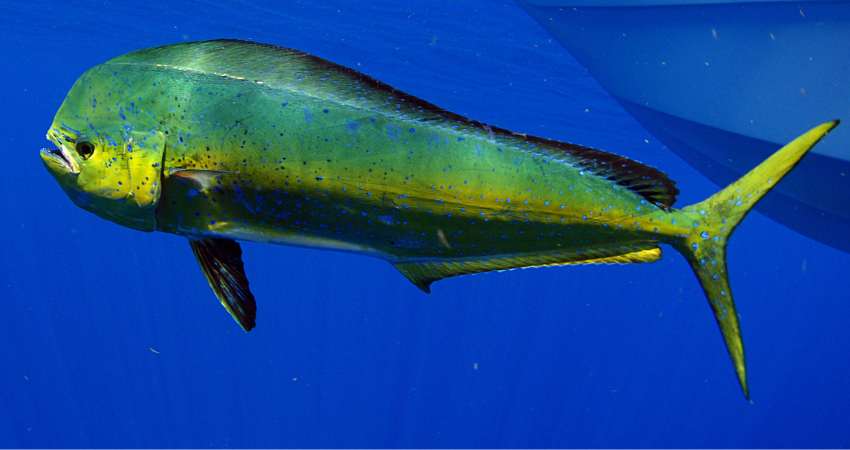Tuna vs Mahi Mahi – What’s The Difference? Is Tuna Better?
Tuna and Mahi Mahi have amazing nutritional value and in some ways are similar. For this reason many people ask about their differences. Let’s answer the question, what is the difference between tuna and Mahi Mahi?
Tuna and Mahi Mahi are different species from different families. Mahi Mahi colors are electric green and yellowish while tuna is blueish and silvery. Tuna has a stronger taste and fishier flavor than the mild to sweet flavor tasting Mahi Mahi. Tuna contains more B vitamins, minerals and protein than Mahi Mahi.
This article will compare their tastes, textures, cooking methods, costs, mercury levels and whether one can substitute for the other in recipes. In addition, I’ll do a side-by-side comparison of their nutrients, habitats, size, weight and more.
Tuna and Mahi Mahi Nutrition Value
The following table is a side-by-side comparison of all the nutrients per four ounces:
| Nutrient | Tuna, raw (4 Ounces) | Mahi Mahi, raw (4 Ounces) |
| Calories | 124 | 96 |
| Fat | 0.6 g | 0.8 g |
| Saturated Fat | 0.2 g | 0.2 g |
| Cholesterol | 44 mg | 83 mg |
| Protein | 28 g | 21 g |
| Omega-3 | 0.12 g | 0.13 g |
| B-6 | 1.0 mg | 0.4 mg |
| B-12 | 2.3 mcg | 0.6 mcg |
| Thiamin | 0.10 mg | 0.02 mg |
| Riboflavin | 0.10 mg | 0.07 mg |
| B5 | 0.2 mg | 0.8 mg |
| Niacin | 20.9 mg | 6.9 mg |
| Folate | 2.2 mcg | 5.6 mcg |
| Iron | 0.8 mg | 1.2 mg |
| Potassium | 500 mg | 471 mg |
| Magnesium | 39 mg | 34 mg |
| Phosphorus | 315 mg | 162 mg |
| Calcium | 4.5 mg | 17.0 mg |
| Zinc | 0.4 mg | 0.5 mg |
| Selenium | 102.7 mcg | 41.3 mcg |
Both fish contain a wide variety of similar nutrients. One contains more of some nutrients while the other contains more of other nutrients. Therefore, let’s take a close look at which one is healthier.
Tuna is healthier than Mahi Mahi due to its higher percentage of B vitamins and minerals. It contains more protein, less cholesterol and fat. Tuna provides a higher percentage of B6, B12, thiamin, riboflavin, niacin, potassium, magnesium, phosphorus and selenium than Mahi Mahi.
Mahi Mahi is no slouch either and is very healthy. This makes many people want to add Mahi to their diet. It provides a higher percentage of B5, folate, iron, calcium and zinc.
Both fish, tuna Mahi, provide almost the same amount of heart healthy omega-3 fatty acids.
Mahi calories are less per four ounces.
Keep reading because the next section explains why omega-3s are important for health.

Tuna and Mahi Mahi Health Benefits
Both fish provide the same nutrients and therefore the same benefits. Although I broke down the benefits by which fish offers the higher percentage of each nutrient ((FDA: Seafood Nutrition Facts)). Since omega-3 fatty acids are similar, I’ll start with them.
Omega 3 Fatty Acids
Tuna provides 0.12 grams of omega-3 per four ounces raw. Why does omega-3 fatty acids matter so much?
It’s because omega-3 fatty acids are heart healthy and help keep arteries healthy. The omega-3s in tuna and Mahi Mahi may help with the following:
- Keeping bad cholesterol low.
- Keeping good cholesterol high.
- Reducing inflammation.
- Reducing plaque build-up.
- Lowering triglycerides
- Help keep the heart rhythms more normal.
DHA and EPA, two of the fatty acids, are associated with lowering blood pressure and improving the health of blood vessels ((National Center for Biotechnology: Marine Omega-3 Supplementation and Cardiovascular Disease)).
Studies suggest omega-3s can help reduce joint pain and stiffness in people with rheumatoid arthritis. They may also boost the effectiveness of anti-inflammatory drugs.

Tuna Health Benefits
B Vitamins
Of the seven B vitamins listed in the table above, tuna contains more of five of them. The B vitamins in the table include B6, B12, B5, B1 (thiamin), B2 (riboflavin), B3 (niacin) and B9 (folate). B vitamins help support the following:
- Cardiovascular disease
- Red blood cells
- Digestion
- Energy levels
- Brain function
- Nerve function
Selenium
Selenium is an underreported nutrient. I’m unsure why many don’t write about it more because studies4 show selenium may help to protect the following:
- Heart disease
- Thyroid
- The immune system
- Cognitive issues
Potassium
Since the recommended daily amount is 4,700 mg, they both fish provide an excellent number.
Potassium is beneficial for reducing sodium intake. It helps the body reduce fluids and rids excess sodium ((American Heart Association: How Potassium Can Help Control High Blood Pressure)). This process helps to reduce blood pressure.
The more potassium you consume, the more sodium your body will lose. Consuming too much sodium or not enough potassium throws off the delicate balance the kidneys need to remove the excess water5.
According to Harvard Health, a number of studies have shown a connection between low potassium levels and increased blood pressure6.
Magnesium
Adding magnesium to your diet could be instrumental in improving sleep related issues like insomnia. Magnesium relaxes and calms the whole body including the blood vessels ((National Institutes of Health: Magnesium)).
More so, it helps keep blood pressure levels balanced and stable. A recent study researched 22 studies and concluded magnesium supplementation decreased diastolic and systolic blood pressure7.
Magnesium in tuna helps control muscle and nerve function, blood sugar and blood pressure. In the muscles and heart, magnesium competes with calcium to help the muscles relax after contracting.
When the body is low in magnesium, calcium can over stimulate the heart muscle’s cells causing a rapid or irregular heartbeat.
Phosphorus
Tuna provides almost double the number. Phosphorus has been shown in studies to may help the following:
- Muscle contraction.
- Muscle recovery after exercise.
- Promoting healthy nerve conduction.
- Promote bone and teeth strength.
- Aids the kidneys in waste removal.
- Help the body manage and store energy.
If you’re wondering how it compared to cod, check out my article, Cod – What’s The Difference? Let’s Compare.
Mahi Mahi Health Benefits
Calcium
Calcium is important for blood pressure and the heart.
Harvard Health reports calcium helps maintain blood pressure because it helps to control the relaxing and tightening of blood vessels8. Calcium also helps the following:
- Build and maintain strong bones.
- Muscles need calcium to function properly.
- Improve nerve function.
Tuna and Mahi Mahi: Tastes and Textures
One of the most important things people takes into consideration when choosing a fish is its taste. When comparing the two fish, tuna vs Mahi Mahi, let’s determine which one has the better taste.
Tuna has a stronger and fishier flavor than Mahi Mahi. Mahi Mahi is more mild to sweet and does not taste fishy. If a fishy or meatier taste is desired tuna is better. If a fishy flavor is undesirable, then Mahi Mahi is better. Mahi Mahi has a firmer texture than slightly mushy tuna.
Tuna has a meaty and mushy texture. It is not flaky. When used as an ingredient in a meal, it adds a creamy flavor and texture. It is also oily but not as much as some other oily fish.
Mahi-Mahi taste can range from mild-flavored to sweet depending which part of the flesh you’re eating. The darker area has a more pronounced flavor similar to swordfish but not as much. Its firm, moist texture has large flakes.
I conducted original research on taste by polling my clients, members of food groups and readers. I asked them which fish tasted better?
- 52% preferred the Mahi Mahi.
- 48% preferred the tuna.
It was almost an even split. To conduct more research on taste I set up a blind taste test at my home. Both fish were prepared and seasoned the same way. Three out of four chose the Mahi Mahi due to its less fishier taste.
If you’re wondering how brown trout and rainbow trout differ in taste, check out my article, Rainbow Trout vs Brown Trout – What’s The Difference?
Substitutions
When preparing recipes for dinner it’s not always possible to locate the type of fish called for. If you have some one fish only, you may wonder if you can substitute one for the other.
Tuna can substitute for Mahi Mahi due to their similar textures although tuna’s flavor is stronger. They both have a firm enough texture allowing similar cooking methods when substituting. Both fish can be grilled, baked, roasted, poached, fried or seared.
Other tuna substitutes include the following:
- Salmon
- Bluefish
- Black Sea bass
- Swordfish
- Salmon steak
The best Mahi Mahi substitutes are:
- Salmon
- Striped bass
- Cod
- Rainbow trout
- White Sea bass
- Tuna

When substituting either fish always stick to the following:
- Same size and weight.
- Stick with similar fillets, whole fillet or cross section.
- Stick with skinless or skin when the recipe calls for one.
- Texture is more important for certain cooking methods. Like using a firmer texture when grilling9.
Canned tuna is very popular. Growing up tuna salad on toast was one of my favorite sandwiches. If you planned on using it but don’t have any available, what can you substitute for it?
Canned tuna substitutions:
- Canned pink salmon
- Canned red salmon
- Canned sockeye salmon
- Canned coho salmon
Canned tuna can substitute for canned salmon. Although the taste and color will be different, they can be prepared the same way using equal amounts according to the recipe. The other ingredients and preparation time can remain the same.
If you’re wondering how it and salmon differ, check out my article Salmon: Which Is Better?

Cost
The costs for fish will vary depending on how the fish are caught and where they are sold. When purchasing fish, be sure to check the label to see if it is wild-caught or farm raised.
Therefore, let’s take a close look at the costs of both fish.
Mahi Mahi is more expensive than tuna. The average cost for wild caught Mahi Mahi is $18.99 per pound while the average cost for wild caught tuna is $14.99 per pound.
To conduct original research on costs I visited various different stores to check their prices.
First, I checked the local Freshdirect online supermarket for the current prices.
- Wild Mahi Mahi fillet
- $18.99 per pound
- Fresh, wild caught tuna fillet Yellow-fin
- $7.98 per pound
- Fresh tuna steak Ahi
- $10.99 per pound.
- Fresh tuna steak Yellow-fin
- $26.00 per pound

Tuna vs Mahi Mahi Mercury Levels
The EPA and The Food and Drug Administration have issued warnings and suggestions regarding mercury levels in fish and how often they should be consumed10.
They established a list of best fish, good choices and ones to avoid based on their mercury levels. let’s examine which fish has more mercury.
Tuna and Mahi Mahi have similar levels of mercury. They are both listed on the FDA’s good choices of fish to consume regarding their mercury levels. The recommendation is consuming one serving per week for fish listed as good choices.
Always check with a physician prior to eating new foods or changing your dietary habits.
Tuna Mahi: Habitats, Size, Weight, Appearance?
Are tuna and Mahi Mahi the same?
Tuna and Mahi Mahi are not the same, they are two different species of fish. The average tuna is longer and weighs more than Mahi Mahi. Tuna have a blueish back while Mahi Mahi have an electric green color back. Depending on the species, tuna can live up to 40-50 years and Mahi Mahi up to 5 years.

Scientific Classifications, Families, Species
Tuna are from:
- Family: Scombridae
- Tribe: Thunnini
- Genus:
- Allothunnus
- Auxis
- Euthynnus
- Katsuwonus
- Thunnus
The true tunas belong to the genus thunnus. There are 15 species including bluefin, yellowfin tuna, albacore, bigeye, longtail and more.
How About Ahi?
Ahi tuna refers to two tunas. Tuna ahi, in Hawaii, refers to yellowfin and bigeye. Ahi or fish ahi, are just different species of tuna and are not Mahi Mahi.
Mahi Mahi are from:
- Family: Coryphaenidae
- Genus: Coryphaena
- Species: C. hippurus
Habitats
- Tuna inhabit the open waters and live near the coast and offshore. They are found in The Atlantic, Pacific and Indian Oceans, Mediterranean Sea and the Gulf of Mexico.
Mahi Mahi can be found worldwide. Some of the common places include the following:
- The west coast of North and South America
- Hawaii
- The Atlantic coast of Florida and Africa
- The Gulf of Mexico
- The Pacific coast of Costa Rica
- Indian Ocean
- South China Sea
- Southeast Asia
- Caribbean
Approximately one-third of the U.S. Mahi Mahi comes from the Atlantic Ocean, Gulf of Mexico and the Caribbean. The remaining comes from the Pacific Ocean near Hawaii.
Colors
- Tuna have shades of dark blue near the top with silvery to white sides and bottom.
- Mahi Mahi is an electric greenish blue towards the top. The lower body is goldfish and the tail appears yellowish.
Appearance
- Tuna have a round middle that tapers in the front and rear. Their body is long.
- The Mahi Mahi adult males have a square head while the females have a rounded head. The have about 55-66 dorsal fin rays extending from the head almost to the tail. Their bodies are more compressed.
Size and Weight: Including Albacore Tuna
- The average tuna’s weight and size varies greatly depending on the species. Typical adults measure between four and eight feet long. An albacore tuna grows to 79 pounds, yellowfin to 397 pounds and northern bluefin tuna to 1,800 pounds.
- Mahi Mahi grow an average 39″ in length and weighs 15-29 pounds.
Age
- The average tuna lives:
- Atlantic Bluefin tuna lives up to 50 years.
- Albacore: 9-13 years
- Bigeye: 5-16 years
- Pacific bluefin: 15-26 years
- Longtail: 18 years
- Yellowfin: 5-9 years
- Mahi Mahi lives up to 5 years but seldom exceed 4 years.
As a Certified Health Coach, many of my clients ask me about seafood. In addition to coaching clients about tuna and Mahi Mahi, I’ve purchased, researched and consumed both fish for over 20 years.
If you have any questions about this article or other featured content, don’t hesitate to email and notify us. You can find an email on our contact page. We’ll do our best to reply as soon as possible.
Read Next – More Fish vs Fish Articles!
Herring vs Sardines – What’s The Difference? Let’s Compare
Brook Trout vs Brown Trout – Let’s Compare The Differences
White Perch vs White Bass: Which Is Better?
Alaska Pollock vs Atlantic Pollock: Which Is Better?
White Bass vs Striped Bass: The Key Differences
- Nutrition Value: Fish, raw, mahimahi [↩]
- Nutrition Value: Tuna, raw, fresh [↩]
- FDA: Fish, tuna, fresh, yellowfin, raw [↩]
- National Institutes of Health: Selenium [↩]
- National Center for Biotechnology Information: The Effect of the Sodium to Potassium Ratio on Hypertension Prevalence: A Propensity Score Matching Approach [↩]
- Harvard Health: Potassium lowers blood pressure [↩]
- National Center for Biotechnology Information: Effect of magnesium supplementation on blood pressure: a meta-analysis [↩]
- Harvard Health: Key minerals to help control blood pressure [↩]
- Sea Grant North Carolina: Fish Flavors and Substitutions [↩]
- FDA: Advice about Eating Fish [↩]
